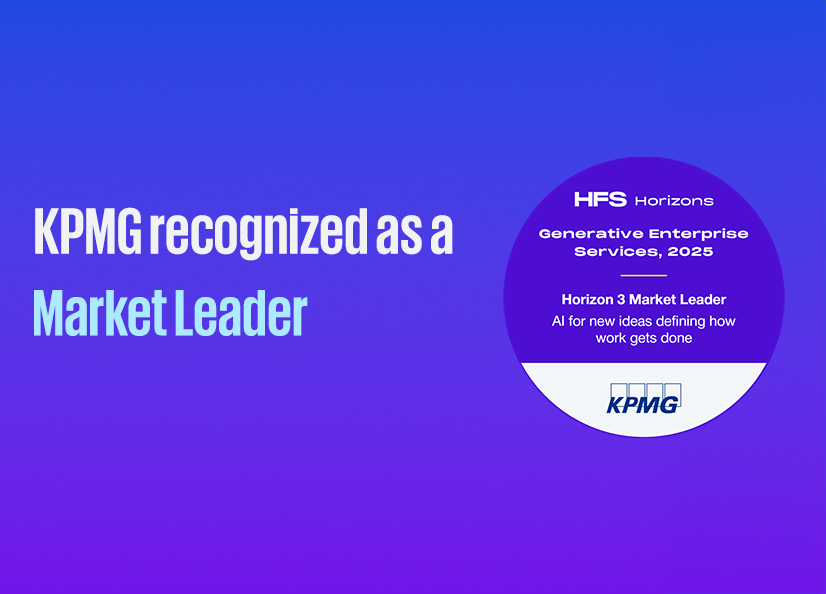The perfect fit: Unlocking new value with GenAI
KPMG is helping a global footwear leader expand AI capabilities and develop powerful new applications.
Read more

Discover how we integrated custom data insights and leveraged AI to transform and accelerate real-time tracking, testing, and budgeting, enhancing decision-making, and setting new standards in M&A integration.
KPMG is helping a global footwear leader expand AI capabilities and develop powerful new applications.
Read moreA state Medicaid agency called on KPMG to develop a robust new framework for Trusted AI adoption.
Read moreWe implemented an AI-powered conversational system that used real-time text-to-speech technologies for seamless customer interactions.
Read moreUsing data-driven insights and AI-powered predictive analytics to help define a new era in women’s golf.
Read moreWith extensive experience, advanced AI technologies and accelerators, and a powerful network of strategic alliances and investments, we can help you unlock the power of AI to shape and continuously evolve your future.


We collaborate with the world's leading AI innovators to drive your success. Our portfolio ecosystem of alliances and startups empower your business with an expansive range of AI capabilities and solutions, seamlessly integrated across multiple platforms. With KPMG, you gain a sustainable competitive edge, powered by the best in tech.

KPMG Ignite | Blaze
End-to-end acceleration for your journey to a modern enterprise.

Focus on high-value commercial loan servicing activities
Get an assist from GenAI

Unlock efficiency in product labeling with KPMG AI LabelWise
Improve your life sciences labeling process
aIQ combines the power of artificial intelligence with KPMG’s human intelligence quotient. The lowercase “a” shows how AI plays an enabling role to the capitalized "IQ", our human intelligence that ultimately drives our capabilities and future advancements.
KPMG aIQ is transforming the way we work by integrating AI in bold, fast and responsible ways to unlock new potential. Our human-centric approach to becoming an AI-driven firm is rooted in our Values and guided by our Trusted AI principles. By equipping our workforce with the tools and skills needed to harness AI effectively and ethically, we are enhancing daily operations, improving decision-making capabilities, and creating better experiences for our people and clients.


Industry leader

Alliances

We collaborate with the world's leading AI innovators to drive your success. Our portfolio ecosystem of alliances and startups empower your business with an expansive range of AI capabilities and solutions, seamlessly integrated across multiple platforms. With KPMG, you gain a sustainable competitive edge, powered by the best in tech.
AI solutions

KPMG Ignite | Blaze
End-to-end acceleration for your journey to a modern enterprise.

Focus on high-value commercial loan servicing activities
Get an assist from GenAI

Unlock efficiency in product labeling with KPMG AI LabelWise
Improve your life sciences labeling process
KPMG aIQ
aIQ combines the power of artificial intelligence with KPMG’s human intelligence quotient. The lowercase “a” shows how AI plays an enabling role to the capitalized "IQ", our human intelligence that ultimately drives our capabilities and future advancements.
KPMG aIQ is transforming the way we work by integrating AI in bold, fast and responsible ways to unlock new potential. Our human-centric approach to becoming an AI-driven firm is rooted in our Values and guided by our Trusted AI principles. By equipping our workforce with the tools and skills needed to harness AI effectively and ethically, we are enhancing daily operations, improving decision-making capabilities, and creating better experiences for our people and clients.

Demonstrated results

Explore our latest thinking on how to realize the many benefits of integrating AI across your enterprise.

Agents of change: New organizational roles in the age of AI
AI is redefining work and leadership. Discover the capabilities and structures needed to build adaptive, innovative human-AI teams, and unlock the full potential of digital collaboration with AI Agents as your strategic teammates.

Shadow AI is already here: Take control, reduce risk, unleash innovation
Discover how forward-thinking organizations are turning unsanctioned AI use into a launchpad for innovation and growth. Learn how to reduce risk, empower employees, and build a future-ready AI strategy.

You can with AI.
A podcast series that will fuel your organization’s AI transformation from the top

The agentic AI advantage: Unlocking the next level of AI value
Learn how agentic AI can unlock enterprise value, supercharge adoption, boost workforce productivity, and revolutionize process engineering.

Trust, attitudes and use of Artificial Intelligence
A global study 2025 – US insights.

KPMG AI Quarterly Pulse Survey
Leading with AI: Executives are betting big on scalable impact

Quantifying the GenAI opportunity
Discover how GenAI can unlock a massive, untapped opportunity for businesses, and learn what it takes to capture its value.

Intelligent Banking
This report explores AI’s pivotal role in banking, highlighting its transformative impact and providing insights for leaders at every stage, from initial pilots to scaling initiatives.
Read our 3-part insights article series on the most essential issues on clients’ minds as we navigate the AI era. Our insights are backed up by internal learnings from our internal AI transformation journey.

KPMG’s aIQ Journey
A strategic blueprint for AI across the enterprise

A primer on human-centric AI
How to ensure your AI transformation puts humans first

Essential elements of responsible AI
How solid guardrails can help you scale AI faster
Connect with our team today to learn how we can help you realize the full potential of GenAI.
